Leeds United hosted Blackburn Rovers at Elland Road just before the international break. Leeds started to see a silver lining in their EFL Championship campaign this season with their win over Queens Park Rangers. They hoped to carry forth the momentum of the previous win in this game against Blackburn. The visitors, however, have been struggling with form and are in the 18th position on the league table.
Leeds managed to see this game home with a comfortable 2-1 win. With their dynamic rotations in attack and resilient defensive work rate, they were able to stick to their playing principles and keep Blackburn at bay for majority of the game. In this tactical analysis we examine how both teams faced each other.
Lineups
Up until the previous fixture against QPR, Marcelo Bielsa’s tactics for Leeds raised questions due to their poor run in front of goal costing them points in the Championship. Patrick Bamford was unable to convert his chances in front of goal pushing Leeds’ fans to appeal for Arsenal loanee, Eddie Nketiah to be started over Bamford. But Nketiah’s injury meant Bamford would start in his traditional number nine spot. As we saw in the QPR game, Tyler Roberts has been the missing piece to the puzzle in Leeds’ attack.
Thus it was Roberts alongside Mateusz Klich who started behind Bamford. Jack Harrison and Hélder Costa lined up on the flanks. Kalvin Phillips operated as the defensive midfield in front of the central defensive duo of Liam Cooper and Ben White. Stuart Dallas occupied left-back in the absence of Ezgjan Alioski. Luke Ayling played as the right back. We saw Leeds play in a 4-1-2-3 against the 4-4-1-1 of Blackburn with plenty of rotations as we will elaborate in this analysis.
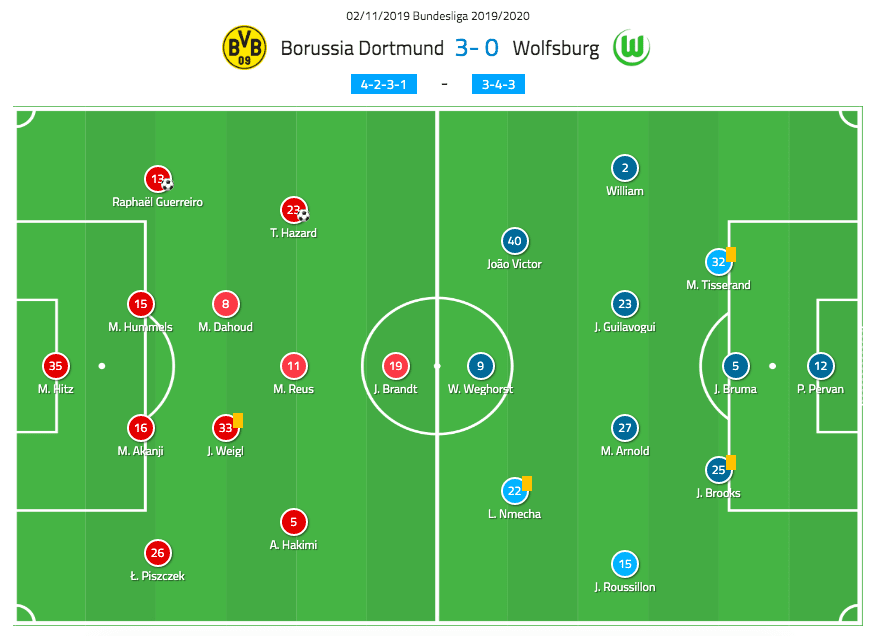
Blackburn’s 4-2-3-1 shaped up more as a 4-4-1-1 playing most of the game in the defensive phase with 33% possession. They played with a back four of Elliott Bennett, Ryan Nyambe, Tosin Adarabioyo and Derrick Williams. Lewis Travis and Lewis Holtby played in central midfield in front of the defence. Adam Armstrong and Stewart Downing operated in the wide areas. Sam Gallagher played as the highest man forward and Bradley Dack played alongside him or behind him.
Blackburn’s strategy against Leeds
Blackburn sat deep in an organised structure with no qualms of yielding the possession statistic to Leeds, but they had a plan. The goal was to force errors from the hosts during the buildup and attack the wide spaces on the counter-attack. There was also a directed strategy to restrict Kalvin Phillips from receiving the ball in the buildup.
We have seen how pivotal Phillips has grown for Leeds especially for his play-making role from deep positions. Blackburn aimed to reduce his influence on the game by using Dack to man-mark Philips. As a result, we saw the two centre forwards giving space for Cooper and White to have the ball but staying compact to deny Phillips space in the hole to receive and turn. With the centre forwards cutting the passing lane and pressing Phillips, Leeds were forced to buildup through their fullbacks. Downing and Armstrong were prepared to make runs on the wide flanks when Leeds lost possession.
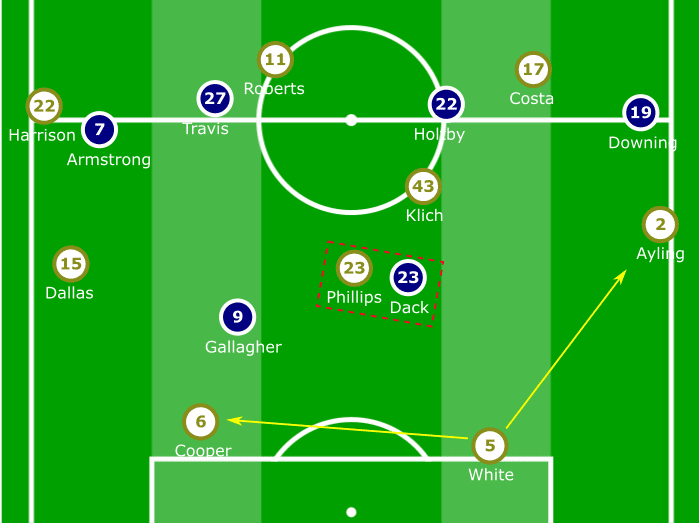
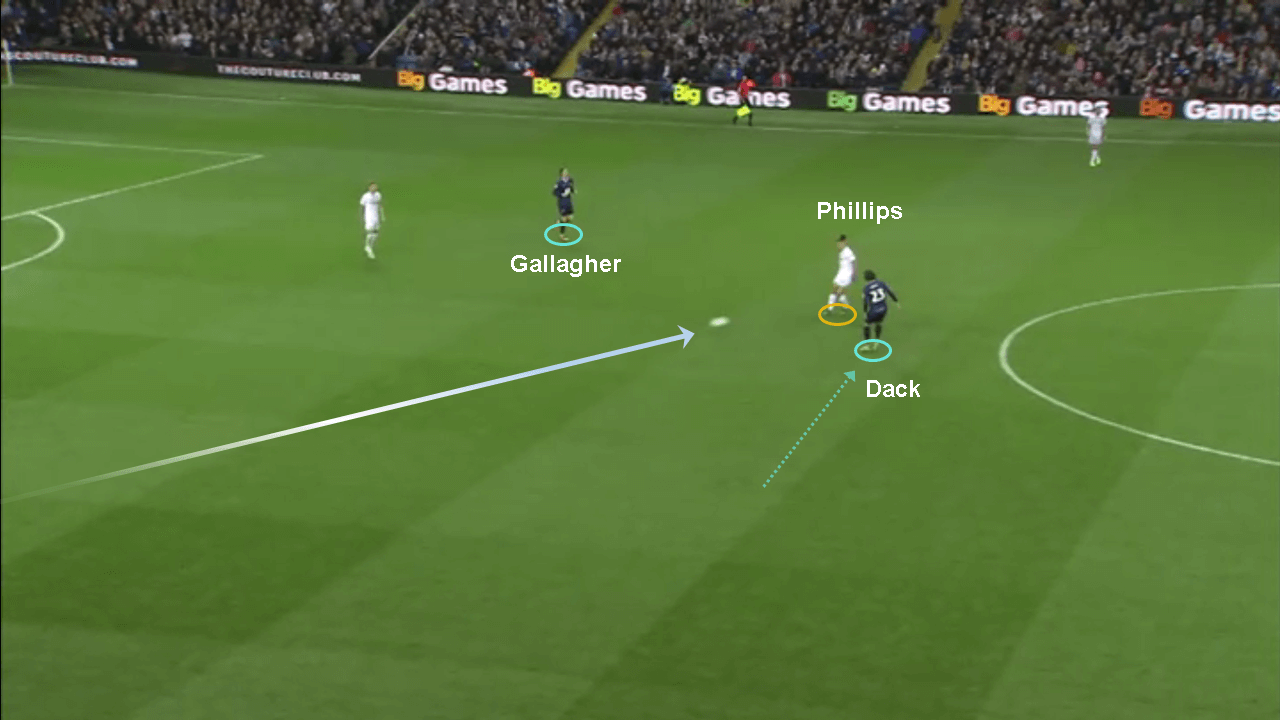
Holtby and Travis also prioritised protecting the spaces in front of the defence which the forwards for Leeds constantly threatened. Because Leeds looked to give the fullbacks, Ayling and Dallas more positional freedom and mobility to attack forward, Klich was required to drop deep as the second pivot and provide an outlet for Leeds to buildup.
Leeds Rotations to create space for each other
A hallmark of Leeds attacking organisation ever since Bielsa took over has been the rotations and interchanges employed by his players. Bielsa’s four core principles are concentración, Permanente movilidad, rotación y repenitización (concentration, permanent focus, rotation and improvisation). This game could be considered one in which his side demonstrated a great deal of all four principles, most notably being the rotations.
Since Blackburn deployed man-oriented pressing in different zones of the pitch, Leeds’ rotations by the players provided an effective strategy to create spaces for each other. In an overview, Kalvin Phillips stayed back along with the central defenders to maintain the extra number over Blackburn’s two strikers. The wingers, Harrison and Costa constantly drifted inside behind the space operated by Bamford and Roberts. Klich had a free role and played as a box-to-box midfielder in the centre. The fullbacks, Ayling and Dallas were able to pick moments to overlap or attack the inside channels and add to the numerical superiority in the attack.
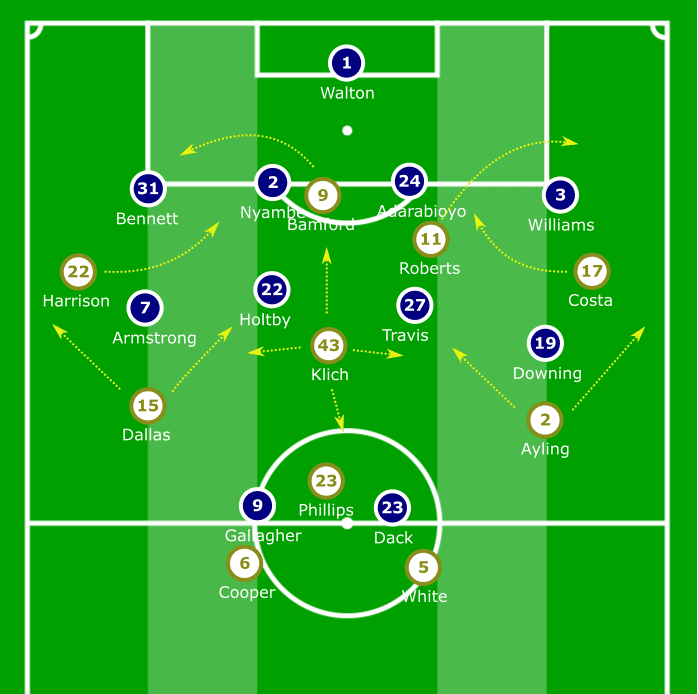
In this graphic below we see an instance of how these rotations enable the Leeds players to make space for each other. We see Dallas makes a run on the inside channel and recovers back in the wide flank, while Jack Harrison, after receiving a pass cuts into the inside channel. Costa moves across the pitch from the other wing, while Klich moves forward dragging their respective markers with them. This makes space for Roberts who comes short from an advanced position. Roberts is able to receive the ball in a dangerous position in front of the Blackburn box and find Bamford who is unmarked in this frame. We also see Ayling moving forward adding to the attacking overload.
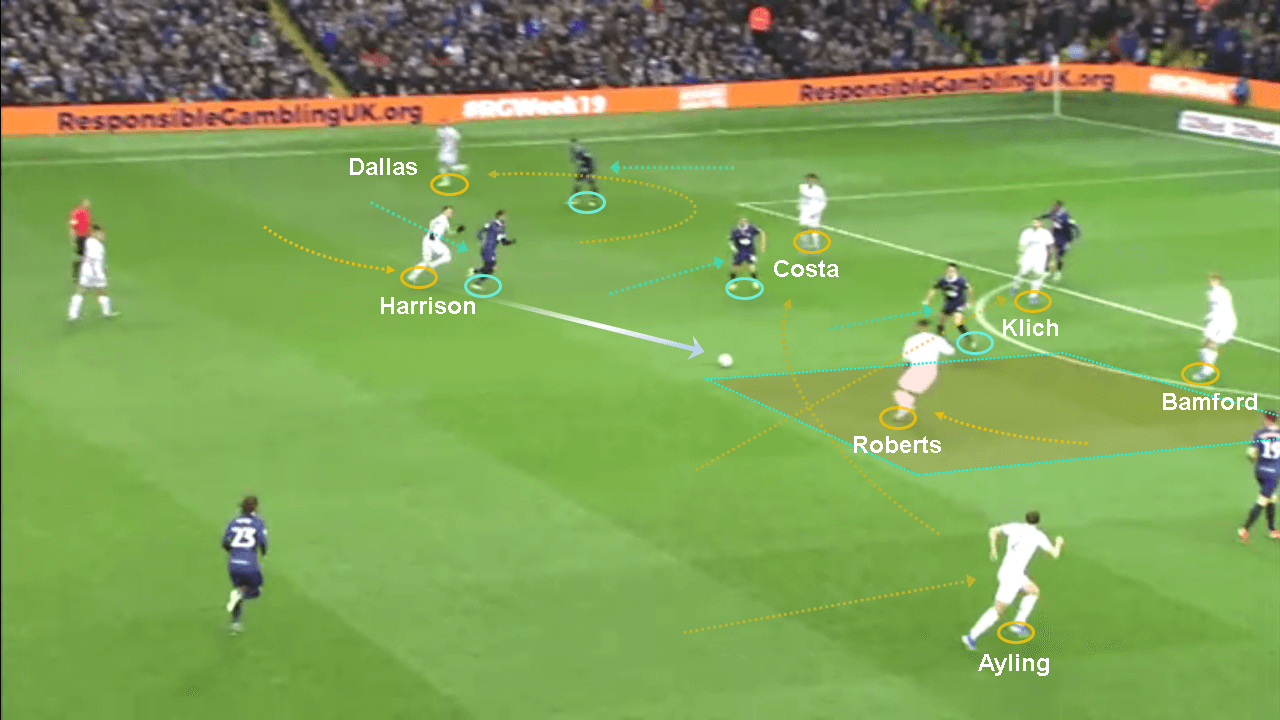
In another frame, we see how Leeds players rotate moving the ball quickly up the pitch while effectively beating their markers. The move is initiated by Dallas who plays the ball vertically up, Harrison cuts inside who lays it to Klich cutting outside from inside, who subsequently lays it off to Bamford and begins moving forward to create a 2v1 with him.
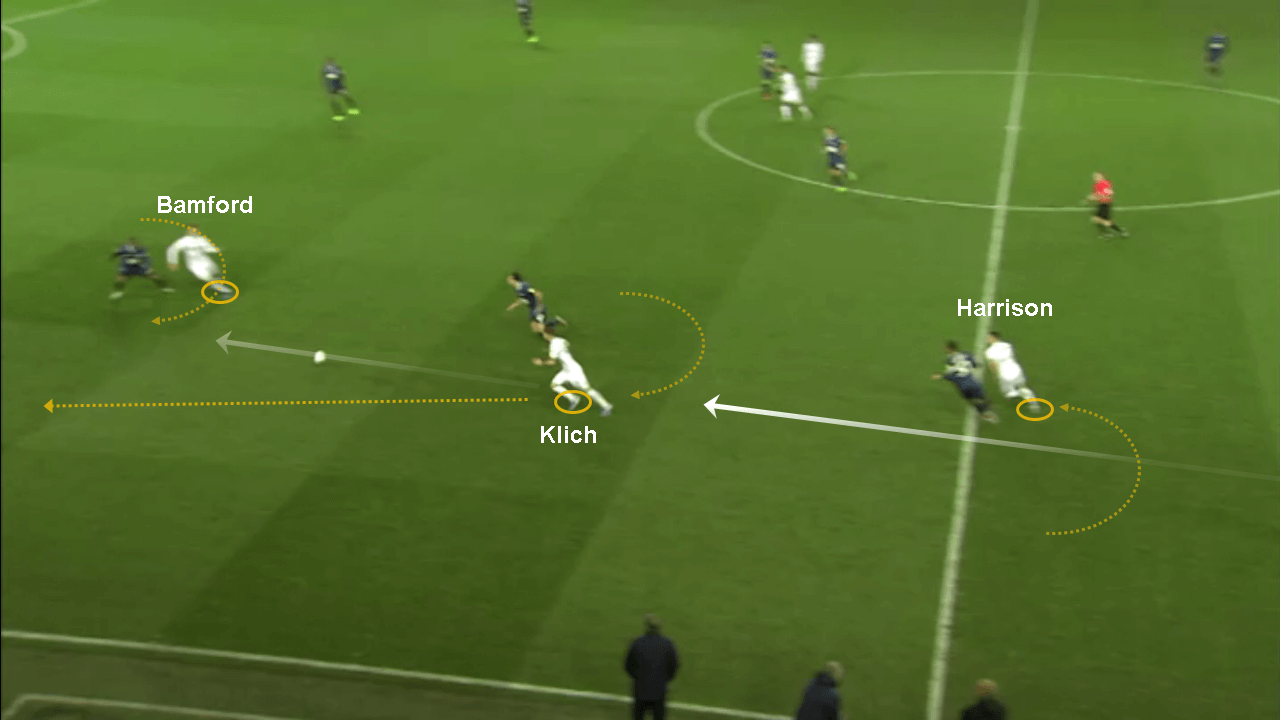
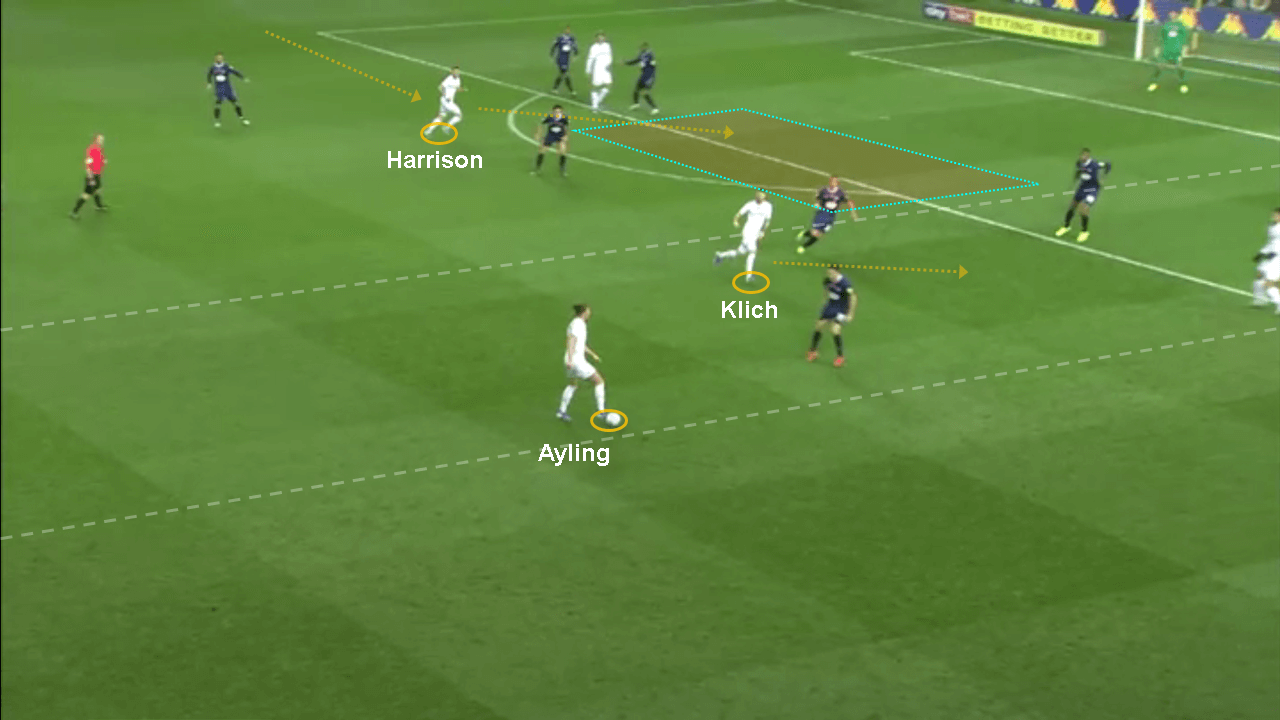
A direct effect of Leeds rotations is that, even if it’s a 2v2 scenario, the movement of players always creates a free player who is free to receive the ball because his teammate is dragging a marker out of position with the rotation. We shall see how Leeds created their goal using this tactic.
Rotations and Bamford’s role in Leeds’ goals
We briefly saw how Leeds’ rotations created spaces for players to move into advanced positions. It shouldn’t come as a surprise that it was Ayling the fullback who won the penalty for Leeds, playing in the position of an inside forward. By converting the penalty, Bamford managed to get on the scoresheet again since 24 August, which was very necessary for the striker’s confidence. Furthermore, we saw how he assisted the second goal, which signified the importance of the role he plays in Bielsa’s system.
In the buildup to the goal, the two-striker press used by Blackburn ensured Philips would have difficulty receiving the ball in the first move from his central defenders. But Klich was able to rotate and move into Philips’ position and receive the pass which he plays back. After playing it back he rotates the position dragging his marker, Travis along with him. While the two forwards are focused on closing the central defenders, Philips manages to sneak back into his position in the second move having rotated with Klich, and now without a marker. He receives the pass from Casilla in the hole.
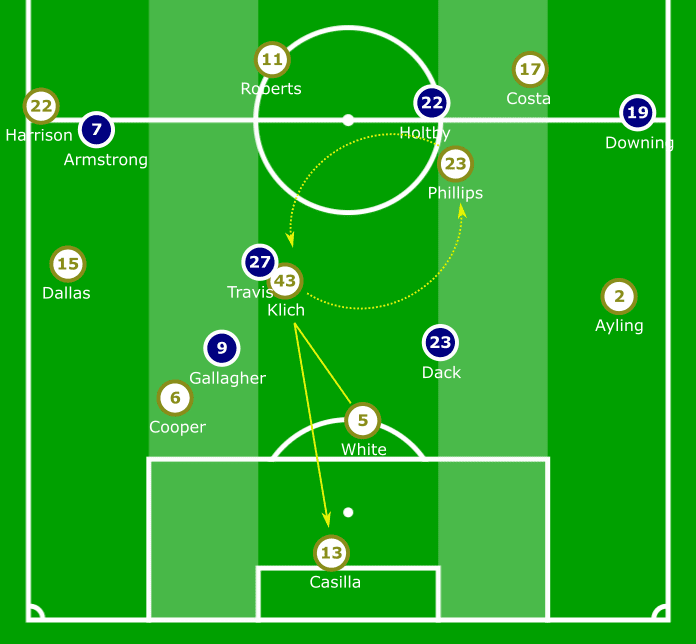
He then advances forward in the space Klich created and plays the long ball to Bamford who is the most advanced player for Leeds. As a typical number nine, Bamford is able to deftly control the ball while pushing the Blackburn defensive line back. Harrison now starts moving inside into the space in front of the Blackburn line. Bamford then lays the ball back into Harrison’s path who neatly converts it for Leeds.
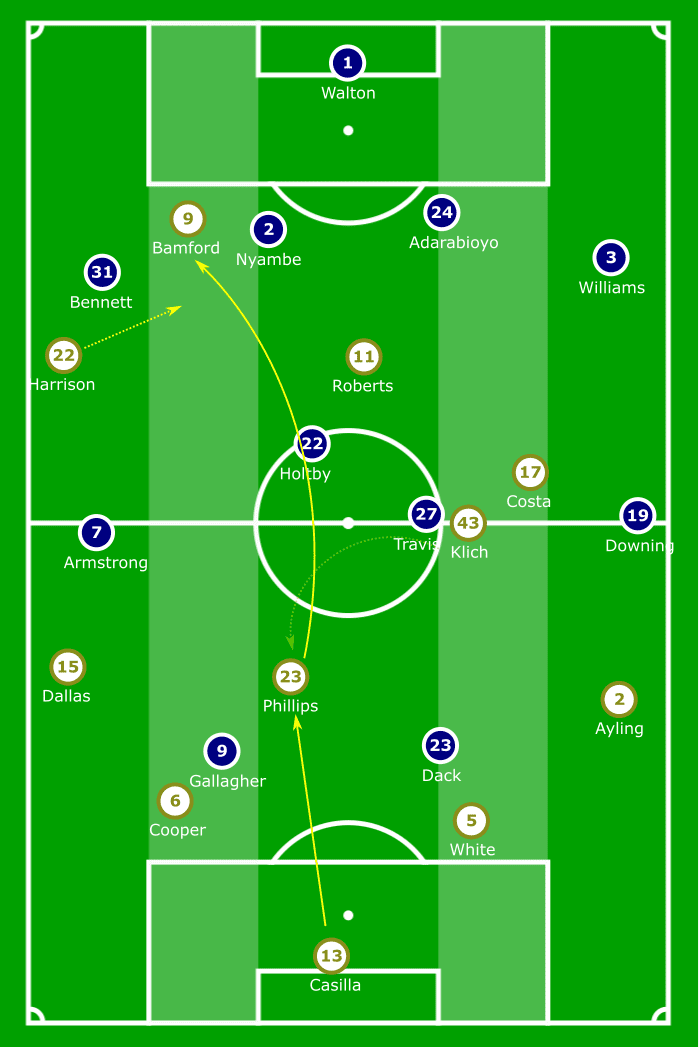
With one goal and one assist, Bamford managed to resurrect his form which had come under heavy scrutiny following the loss of points in previous games.
Costa and Klich dominate central areas
Along with a solid performance by Bamford, Leeds managed to dominate their attacking phases because of the creativity offered by Costa and Roberts. More than previous games, we saw Costa moving into central areas to receive the ball. He also managed four dribbles during the game, into central positions, one of which we can see in this graphic below. By dribbling past his markers he enables his teammates to engage in a quick attacking transition with plenty of space in the centre to exploit.
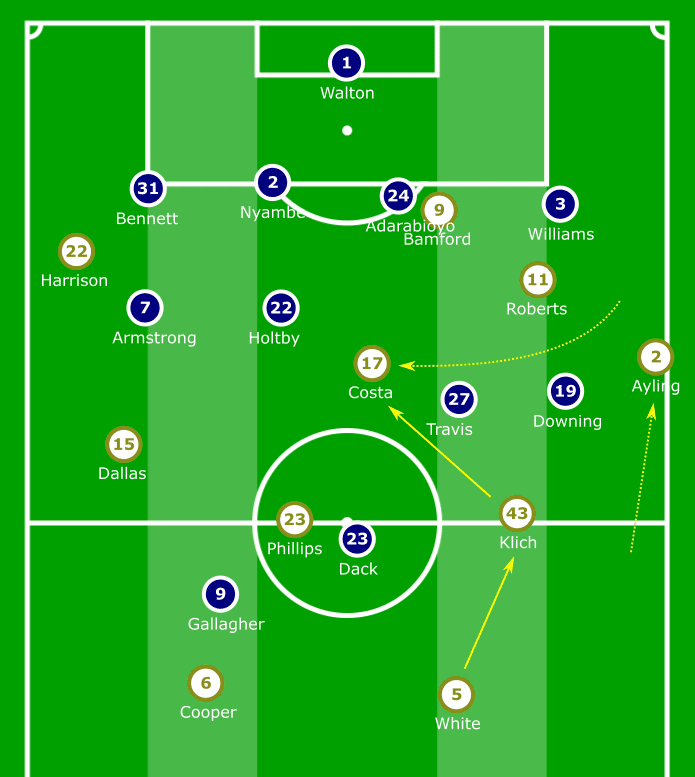
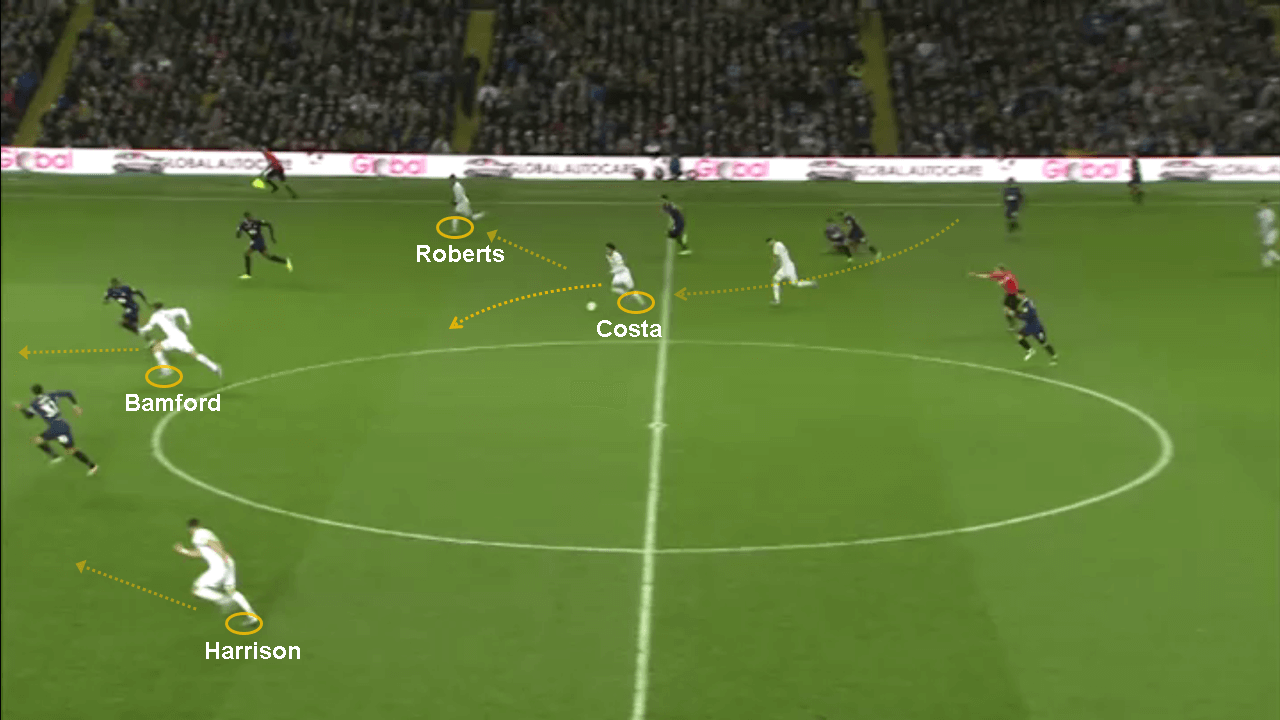
The responsibility to dominate the attacking positions in the centre fell solely on Klich, in the absence of Pablo Hernández, Leeds’ attacking lynchpin. With Costa and Roberts filling in, Klich can focus more on adding stability to the attack. Klich averaged three key passes, two crosses and three accurate long balls out of four attempts during this game. He also won four out of five ground duels and attempted two tackles.
Jack Harrison continues to lead the league for the number of successful dribbles completed. Dallas, who has been utilised as a central midfielder, was able to find spaces in the centre from where he attempted several shots on target. Dallas moving into the centre, while Harrison stayed wide and completed his dribbles shows how the rotations enabled various players to dominate the central areas. We see that the result of Leeds return of form cannot be attributed to one player, but a collective effort by numerous key players.
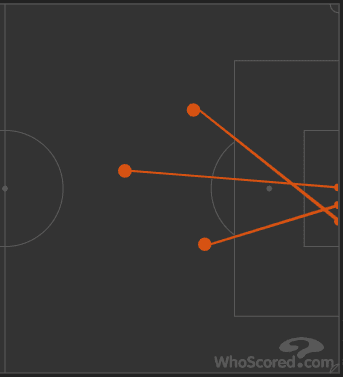
Roberts – the unexpected addition to Leeds’ attack
After the incident in Leeds’ 1-0 win over league leaders West Bromwich Albion, when Roberts was forced to be taken off by Bielsa having come on as a substitute in the second half, as part of a defensive tactic, it was least expected that Roberts would emerge as Leeds’ white knight amidst their crisis. But Roberts, originally a centre forward has embraced the role of the enganche, the attacking pivot in Bielsa’s system like a fish takes the water.
Roberts displays great decision-making ability, phenomenal movement to make space for himself and releases his teammates with sublime timing. His impact in the previous two games can be easily seen and is a significant contribution to Leeds in helping them find their winning ways.
In his heatmap below, we see how he is able to dominate the central attacking positions. He made one key pass and created one big chance along with a 75% pass accuracy and winning five out of eight duels. Roberts also completed 33 passes, 22 of which were forward passes.
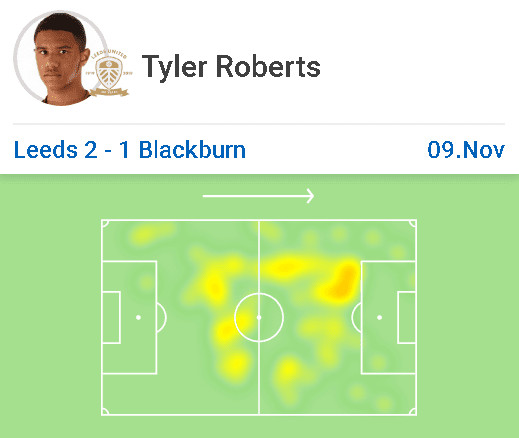
Defensive effort by Leeds
The dynamic positional rotations stole the show for the home side and resulted in their chances, but their victory came as a result of a phenomenal defensive effort. Leeds lost possession 40 times during the game which was more than Blackburn who lost 36 times. But they managed to regain possession 29 times because of immediate counter-pressing after losing the ball. Despite Leeds having 67% of the possession, they attempted 24 tackles, just one short of the visitors.
In this frame below, we see how the Leeds players immediate counter-press from all directions upon giving away possession to Blackburn. This type of counter-pressing gave very little time for Blackburn to react and despite committing many players high up the pitch, Leeds were able to defend the big spaces left behind effectively.
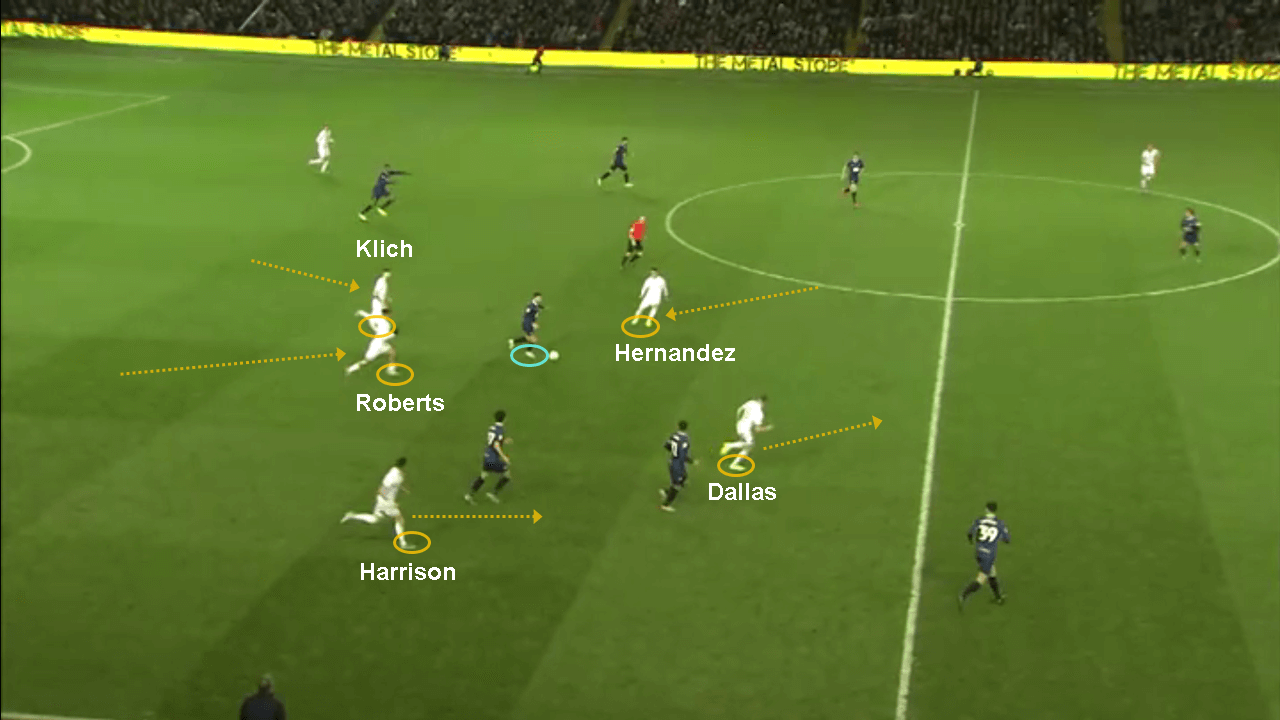
In another instance we see Bamford working hard to recover the ball after losing possession. He tracks back Travis here all the way from the centre forward position running deeper than his teammates. But Bamford’s effort manages to close Travis from the right side forcing him to find the only option in front of him.
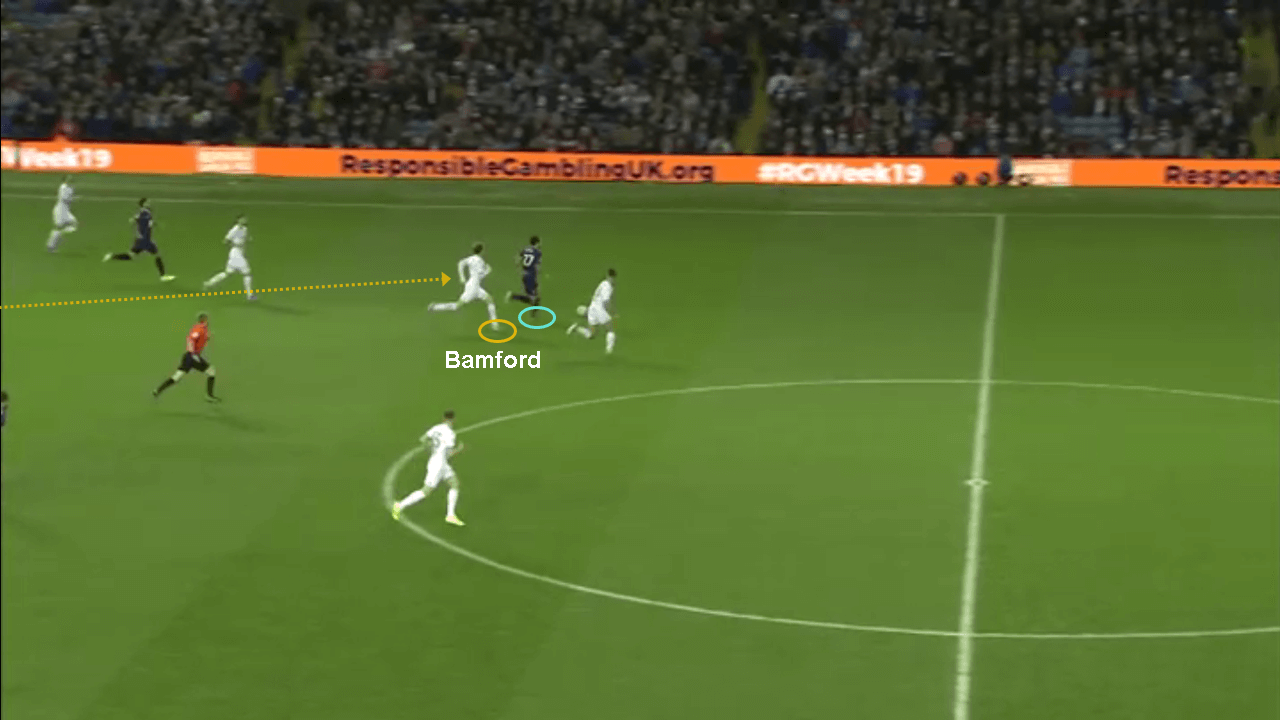
The only clear opportunity that Blackburn converted was from a corner that was poorly defended by Leeds. It was Williams who managed to find a free header as a result of poor marking by Ayling and Philips in front of the six-yard box.
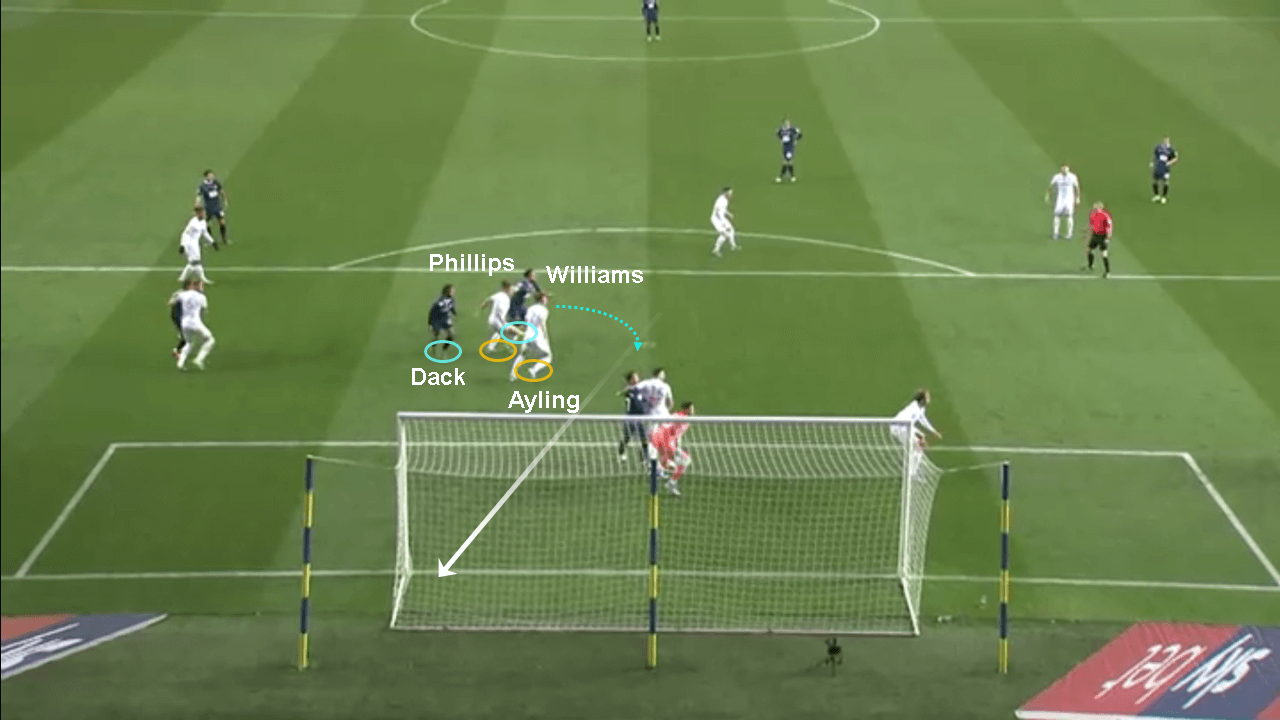
Conclusion
The home side were head and shoulders above the visitors in every department except for set-pieces which justifies the scoreline. Not only did they dominate the attacking phase, they were proactive in attacking and defensive transitions. Despite conceding possession they were able to regain it back immediately and continue pursuing against Blackburn’s goal sticking true to their principles.
Pablo Hernández managed to make an appearance in the last quarter of the game after a long-standing injury indicating a positive sign for the fans at Elland Road. Should Bielsa manage to make his players tick together like clockwork for the remainder of the season avoiding fatigue and injuries, the Yorkshire side might finally prove themselves ready to fight for a Premier League spot by the end of the season, despite being currently in third place two points behind leaders, West Brom.

If you love tactical analysis, then you’ll love the digital magazines from totalfootballanalysis.com – a guaranteed 100+ pages of pure tactical analysis covering topics from the Premier League, Serie A, La Liga, Bundesliga and many, many more. Buy your copy of the November issue for just ₤4.99 here





Comments